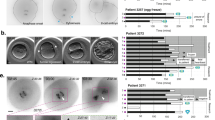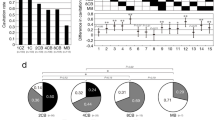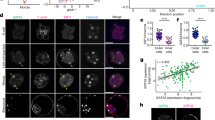Abstract
Arising from: B. Plusa et al. Nature 434, 391–395 (2005); Plusa et al. reply
A recurring question in developmental biology has been whether localized determinants play any role in mammalian preimplantation development1. This is a controversial issue that brings back the idea of prepatterning2,3,4 and is explored further by Plusa et al.5, who claim it is the first cleavage of the mouse zygote that predicts the blastocyst axis, rather than the animal pole or sperm entry point, as previously suggested3. However, other evidence indicates that the blasotcyst axis is not predetermined and there is no prepatterning in the mouse egg6,7,8,9,10,11,12. Here we investigate the origin of these different views and conclude that they arise from differences in the data themselves and in their interpretation.
This is a preview of subscription content, access via your institution
Access options
Subscribe to this journal
Receive 51 print issues and online access
$199.00 per year
only $3.90 per issue
Buy this article
- Purchase on Springer Link
- Instant access to full article PDF
Prices may be subject to local taxes which are calculated during checkout

Similar content being viewed by others
References
Rossant, J. & Tam, P. P. Dev. Cell 7, 155–164 (2004).
Gardner, R. L. Development 128, 839–847 (2001).
Piotrowska, K. & Zernicka-Goetz, M. Nature 409, 517–521 (2001).
Zernicka-Goetz, M. Development 129, 815–829 (2002).
Plusa, B. et al. Nature 434, 391–395 (2005).
Hiiragi, T. & Solter, D. Nature 430, 360–364 (2004).
Alarcon, V. B. & Marikawa, Y. Biol. Reprod. 69, 1208–1212 (2003).
Chroscicka, A., Komorowski, S. & Maleszewski, M. Mol. Reprod. Dev. 68, 308–312 (2004).
Louvet-Vallée, S., Vinot, S. & Maro, B. Curr. Biol. 15, 464–469 (2005).
Motosugi, N., Bauer, T., Polanski, P., Solter, D. & Hiiragi, T. Genes Dev. 19, 1081–1092 (2005).
Alarcon, V. B. & Marikawa, Y. Mol. Reprod. Dev. 72, 354–361 (2005).
Fujimori, T., Kurotaki, Y., Miyazaki, J. & Nabeshima, Y. Development 130, 5113–5122 (2003).
Piotrowska-Nitsche, K. & Zernicka-Goetz, M. Mech. Dev. 122, 487–500 (2005).
Squirrell, J. M., Wokosin, D. L., White, J. G. & Bavister, B. D. Nature Biotechnol. 17, 763–767 (1999).
Vinot, S. et al. Dev Biol. 282, 307–319 (2005).
Author information
Authors and Affiliations
Corresponding author
Rights and permissions
About this article
Cite this article
Hiiragi, T., Louvet-Vallée, S., Solter, D. et al. Does prepatterning occur in the mouse egg?. Nature 442, E3–E4 (2006). https://doi.org/10.1038/nature04907
Published:
Issue Date:
DOI: https://doi.org/10.1038/nature04907
This article is cited by
-
3D convolutional neural networks-based segmentation to acquire quantitative criteria of the nucleus during mouse embryogenesis
npj Systems Biology and Applications (2020)
-
The road to maturation: somatic cell interaction and self-organization of the mammalian oocyte
Nature Reviews Molecular Cell Biology (2013)
-
Non-invasive imaging of human embryos before embryonic genome activation predicts development to the blastocyst stage
Nature Biotechnology (2010)
-
Does prepatterning occur in the mouse egg? (Reply)
Nature (2006)
Comments
By submitting a comment you agree to abide by our Terms and Community Guidelines. If you find something abusive or that does not comply with our terms or guidelines please flag it as inappropriate.



